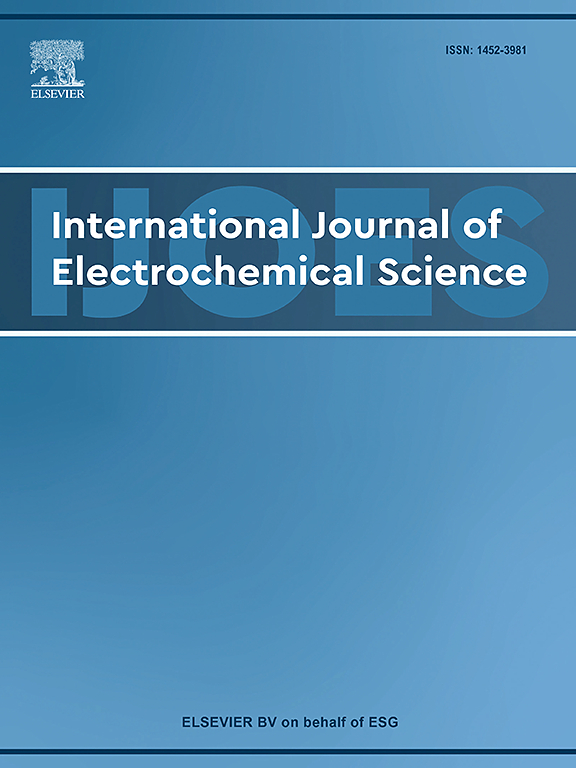Effect of pH on corrosion mechanism of two austenitic stainless steels in artificial sweat
IF 2.4
4区 化学
Q4 ELECTROCHEMISTRY
International Journal of Electrochemical Science
Pub Date : 2025-05-15
DOI:10.1016/j.ijoes.2025.101065
引用次数: 0
Abstract
The sweat is highly corrosive, and its pH fluctuates in the range of 4–7.5 with different physiological conditions. In order to study the effect of sweat pH change on the corrosion behavior of two austenitic stainless steels (304 and 316 L), the failure mechanism was studied by electrochemical experiments and immersion corrosion. Metallographic study results show that the grain size of the two austenitic stainless steels is similar (∼ 16 μm), but the inclusion content (carbides and sulfides) in 304 stainless steel is higher than that in 316 L stainless steel. The results showed that the corrosion current (Icorr) of 304 and 316 L increased significantly with the decrease of sweat pH from 7.5 to 4.5, and Icorr increased by 10.2 times and 8.9 times, respectively. The results of electrochemical impedance spectroscopy show that the decrease of pH will lead to the decrease of the thickness of the passivation film on the surface of the sample, and the roughness of the passivation film increases and the uniformity decreases. Further, the results of 30-day immersion test showed that the corrosion mechanism of the samples in sweat was mainly pitting corrosion. With the decrease of pH, the loss of Cr, Ni, and Mo on the surface of the samples increased, indicating that low pH could promote the migration and loss of Cr, Ni and Mo, resulting in an increase in the degree of corrosion of the samples. The above research results can provide guidance for the design of anti-sweat corrosion materials.
pH对两种奥氏体不锈钢在人工汗液中腐蚀机理的影响
汗液具有很强的腐蚀性,在不同的生理条件下,其pH值在4-7.5范围内波动。为了研究汗液pH变化对两种奥氏体不锈钢(304和316 L)腐蚀行为的影响,通过电化学实验和浸泡腐蚀研究了其破坏机理。金相研究结果表明,两种奥氏体不锈钢的晶粒尺寸相似(~ 16 μm),但304不锈钢中的夹杂物(碳化物和硫化物)含量高于316 L不锈钢。结果表明,随着汗液pH从7.5降低到4.5,304和316 L的腐蚀电流(Icorr)显著增加,Icorr分别增加了10.2倍和8.9倍。电化学阻抗谱分析结果表明,pH值的降低会导致样品表面钝化膜厚度的减小,钝化膜的粗糙度增大,均匀性降低。30 d浸渍试验结果表明,样品在汗液中的腐蚀机制主要为点蚀。随着pH的降低,样品表面Cr、Ni、Mo的损失增加,说明低pH会促进Cr、Ni、Mo的迁移和损失,导致样品的腐蚀程度增加。以上研究结果可为抗汗腐蚀材料的设计提供指导。
本文章由计算机程序翻译,如有差异,请以英文原文为准。
求助全文
约1分钟内获得全文
求助全文
来源期刊
CiteScore
3.00
自引率
20.00%
发文量
714
审稿时长
2.6 months
期刊介绍:
International Journal of Electrochemical Science is a peer-reviewed, open access journal that publishes original research articles, short communications as well as review articles in all areas of electrochemistry: Scope - Theoretical and Computational Electrochemistry - Processes on Electrodes - Electroanalytical Chemistry and Sensor Science - Corrosion - Electrochemical Energy Conversion and Storage - Electrochemical Engineering - Coatings - Electrochemical Synthesis - Bioelectrochemistry - Molecular Electrochemistry

 求助内容:
求助内容: 应助结果提醒方式:
应助结果提醒方式:


